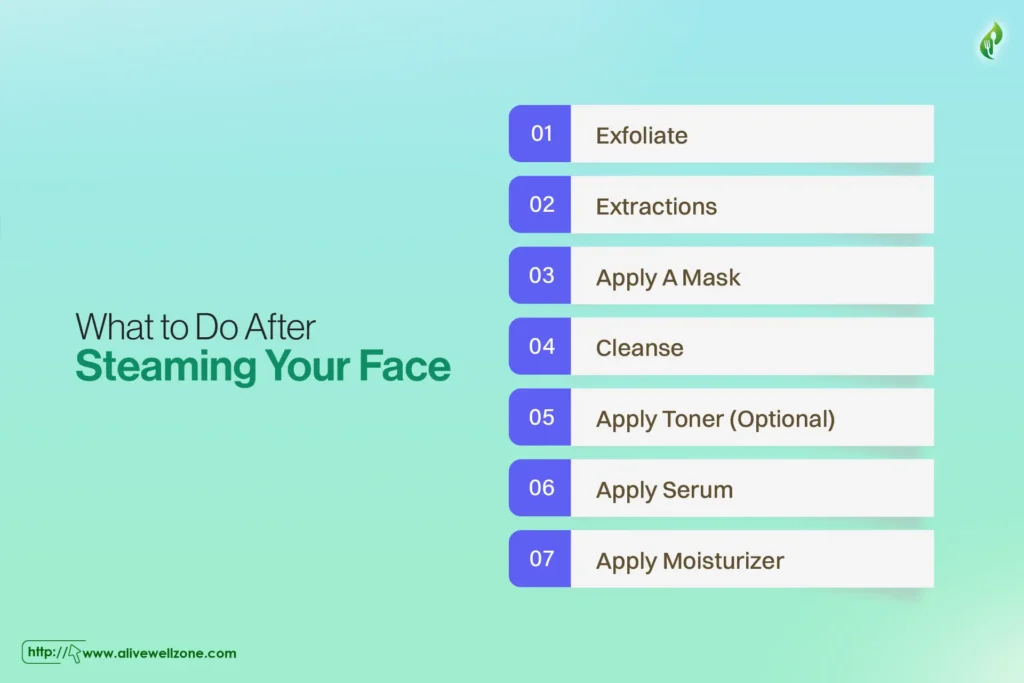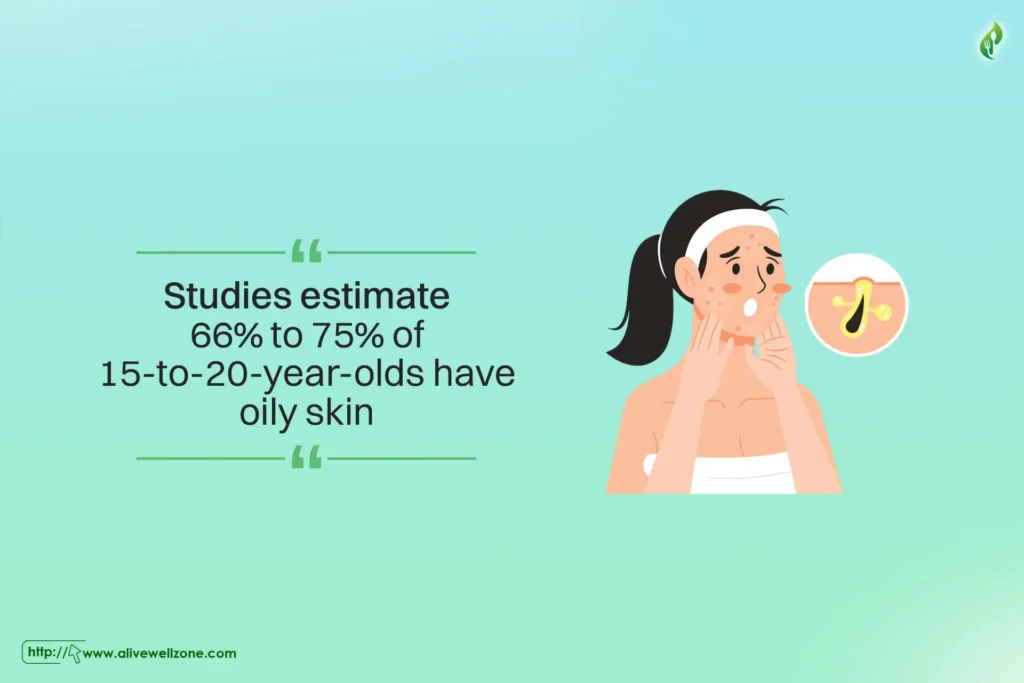
Last Updated on August 30, 2025 by Helena Akter
Just after a rejuvenating facial steaming session, you’re ready to unveil the post-steam glow. But what to do after steaming your face? Can steamy goodness alone make your skin glow and feel fresh? It’s not done yet. You’ve got a few things to do after you steam your face.
Post-steaming the pores of your skin unclog allowing you to exfoliate. Then. you can apply different masks, and then use ice or toner to tone your skin. Following that, apply serum to maximize the benefits and finish up by applying moisturizer.
If you have sensitive, oily, dry, or blackhead-prone skin, we’ll help you maintain healthy skin. You’ll get a walk-through of everything you need to do after steaming, including cleansing, toning, serums, and moisturizers.
What Is Facial Steaming?
Facial steaming is pretty straightforward. It’s basically letting your face soak up the soothing steam that heated water generates. But you don’t have to sit over a pot of boiling water like that—it’s not that extreme.
It’s a simple and doable practice that you can easily incorporate into your skincare routine at home. In fact, it’s the same basic concept you’re already familiar with if you’ve ever taken a long shower or used a sauna at a gym.
You only need some hot water, a towel, and just a few minutes of your time to get started. It’s that easy!
What are Some Benefits of Steaming Your Face?

Let’s dive into the beautiful advantages this relaxing skincare ritual brings —
● Improved Blood Circulation
Facial steaming promotes increased blood flow, delivering a fresh supply of oxygen and essential nutrients to your facial tissues. Along with that, perform passive stretching to your routine for improved overall blood flow.
● Banishing Blackheads
Stubborn blackheads and whiteheads don’t stand a chance against the power of facial steam. It helps to loosen and soften these pesky blemishes, making them easier to remove and leaving your skin smoother and clearer.
● Exfoliation and Rejuvenation
Steaming assists in shedding dead skin cells from the outer surface, unveiling a fresh and youthful complexion. So, you can say goodbye to dullness and hello to a revitalized glow.
● Deep Cleansing Action
The mist that forms on your skin during steaming is sweat. It works hard to flush out accumulated dirt, debris, and dead skin lurking beneath the surface. It goes beyond your daily cleansing routine, giving your skin a thorough detox.
What to Do After Steaming Your Face

You might think the skincare session is over after steaming your face. But it’s the beginning. Make sure you finish your skincare by following these steps.
1. Exfoliate
When you steam, it loosens up all those dead skin dirt, cells, and impurities. Thus, you can quickly eliminate them by exfoliating afterwards, leaving your skin incredibly smooth, soft, and glowing with radiance.
If you struggle with rough or dry skin, it’ll especially benefit you. Just make sure to choose a gentle exfoliator to avoid any irritation. You can go for either a physical exfoliant like a scrub or rice polish, or a chemical exfoliant.
Remember, stay away from products with harsh seeds and opt for fine particles like rice powder.
No exfoliant? No worries! A trusty washcloth will do the job just fine. Just gently massage your face and neck using light pressure and circular motions. The choice is yours, and your skin will thank you for it!
2. Extractions
Extractions are the process of manually removing hard blackheads, greasy filaments, and clogged pores from your skin.
But remember not to go too extreme with it! To make the process easier, it’s best to use a clay mask or enzyme beforehand. These masks work their magic by loosening up all the gunk, giving you a better shot at successful extraction.
The trick is to use your fingertips or a comedone extractor tool instead of your nails. By doing so, you can minimize pores, and reduce acne. In fact, one of the many uses for diluted tea tree oil is combating acne.
For that, you need to learn how to dilute tea tree oil.
3. Apply A Mask
There are multiple types of masks for various skins. Some of them are —
● Clay Masks for Oily Skin

Studies estimate that 66% to 75% of 15-to-20-year-olds have oily skin. And if you’re one of them suffering from acne, clay masks are your calling. They work wonders by unclogging pores and removing buildup.
However, always get clay masks that contain ingredients like niacinamide and sulfur. That being said, you must know how long to leave clay mask on.
● Sheet Masks for Dry Skin
These masks have gained popularity for their convenience and ease of use compared to other face masks. They’re water-based sheets and are perfect for treating dehydrated skin.
You can find sheet masks infused with different natural ingredients. Some of them are avocado, aloe vera, green tea, citrus fruits, collagen, berries, and tomatoes. For those with dry skin, they are also excellent moisturizers.
● Gel Masks for Sensitive Skin
If you have sensitive skin or suffer from skin irritation, these masks are for you. You can use them to soothe and moisturize your skin. When you apply a gel mask after steaming your face, you will feel hydrated and relieved.
4. Cleanse
Once you remove your mask, it’s important to gently clean your skin to remove any leftovers. It not only cleans out your skin but also prepares it for the next step.
You can use your regular cleanser here. No need for anything fancy.
Keep it simple and let your skin feel refreshed and ready for the next phase of your routine
5. Apply Toner (Optional)
Applying a toner after steaming is an optional step in your skincare routine, but it can offer some great benefits. You can use toners to balance your skin’s pH tighten your pores and dry out excess oil.
That being said, toners aren’t for everyone, and it’s perfectly fine to skip this step if you’ve tried before and didn’t work well for your skin.
If you want to try it, pick a gentle plant hydrosol like rosewater or peppermint. Compared to alcohol-based toners, they’re less harsh.
6. Apply Serum
Time to treat your skin with some nourishing serums! You can use serums to help with acne, fine lines, dark spots, and uneven skin tone. They contain salicylic acid, niacinamide, lactic acid, vitamin C, azelaic acid as well as retinol.
If you prefer something softer, a serum with hyaluronic acid works perfectly.
7. Apply Moisturizer
Applying moisturizer is the last step to get some hydration into your skin Now, if you love using a vitamin C serum, go ahead and apply it before your regular moisturizer.
We’ve got another option for you. And that just slather on your favourite moisturizer and you’re good to go. You can opt for a lotion, natural oils, or creams like jojoba oil or almond to lock in that moisture.
How Do You Close the Pores after Steaming?
While pores don’t technically open or close, steaming does a fantastic job of unclogging them. When those pesky clogs are gone, your skin can better absorb your skincare goodies, making your pores appear smaller.
But don’t fret—pores need to stay open to release oils for a healthy skin barrier. You need to just keep them clean.
And guess what? Wrap an ice cube in a towel and gently glide it over your face for a little tightening boost. You’ll love it when you finish your steamy session with it.
What are Some Things To Avoid When Steaming Your Face?
When it comes to steaming your face, there are some cautions worth keeping in mind.
- First and foremost, moderation is key. You should go for steaming once or twice a month for around seven to ten minutes.
- Avoid excessive steaming as it can actually dry out your skin and leave it looking wrinkly.
- Be cautious of the water temperature as well.
- Don’t let the heat get too hot, it can break capillaries and make your skin sag.
- If you have broken or pimple-y skin, don’t steam.
- Start with healing your skin, then steam for a soothing effect.
What To Do After Steaming Sensitive Skin
If you have sensitive skin, it’s important to give it some extra TLC after steaming.
- Start with a gentle cleanse to make sure your skin is rid of all impurities.
- Make sure that you use mild cleansers and toners to get rid of any lingering dirt. As a bonus, they’ll help remove excess oil without irritating your skin.
- Next, use a hypoallergenic moisturizer without irritants, chemicals, or fragrances. It’ll replenish your skin’s moisture barrier and soothe any sensitivity.
What to Do for Dry Skin After Steaming Face?
To keep your skin nourished and hydrated for a healthy and glowing complexion, you can do the following —
- If you have sensitive skin, make sure you hydrate and moisturize.
- To lock in moisture, look for products containing humectants, such as glycerin and hyaluronic acid.
- Be sure to apply a moisturizer, especially those with natural ingredients such as shea butter and honey. In fact, there are a few things that you can mix with shea butter for glowing skin.
What to Do for Oily Skin After Steaming?
Unfortunately, it’s easy for oily skin to get even oilier after steaming. In that case —
- You can remove extra oil naturally after steaming it with lemon juice diluted in water.
- Also, you can use a soothing rose water toner if you have sensitive skin.
- After steaming, consider using hyaluronic acid serum, aloe vera gel, and pore-tightening sheet masks. With these additions, you’ll be able to balance and refresh your oily skin.
What to Do for Blackheads After Steaming Face?
Once you’ve steamed your face to tackle those pesky blackheads, it’s time to do some extraction. The steam’s heat unclogs your pores, making it a breeze to remove those annoying blackheads without much pain.
Now, if you want to do it at home, make sure you’ve got the right tools like a blackhead vacuum or extractor. But you need to be careful even if your pores are all wide open.
Keep in mind that professionals usually handle extractions because it’s a sophisticated process. So, take care of your skin and seek professional help when in doubt.
FAQs
1. What is the optimal amount of time to steam your face?
Well, the sweet spot is around 10 to 15 minutes. Rather than overdo it and cause your skin to become dry or itchy, that’s the perfect amount of time to get the benefits.
2. How frequently should I steam my face?
It depends on your skin type. If you have a combination of oily skin, steaming twice or three times a week can help. In the case of sensitive skin, it’s best to start with a weekly steam to avoid irritation.
3. Is it okay to steam my face for 5-8 minutes every day?
The frequency of face steaming depends on your skin type. You need to find the right balance when steaming to reduce acne and excess oil. If you steam too much or for too long, your skin may become darkened and dried out.
4. Is it harmful to steam your face every day?
It’s possible for heat to damage your hair and skin. In some cases, heat may lead to a darker complexion and dullness as pores open up. You can, however, clear your face with steam if you use it once or twice a week moderately. Simply put, don’t overdo it.
Final Words
Your skin is unique, so tailor your post-steaming practices to your specific needs to get the best results. You must give your skin the love and care it deserves, not just bask in the steam.
With gentle cleansing, nourishing moisturizers, and targeted treatments, you’ll get a healthy, brighter complexion. Look, we’ve covered all the steps that should be taken following a steaming session. So, make these tips part of your skincare routine to get the most out of facial steam.
Self-care is essential. So go ahead, steam, and glow.







